Contents
- Benefits of Salted Fern
- How to salt a fern for the winter
- Fern salting according to the classic recipe in a large container
- How to salt a fern at home in a dry way
- Fern salting according to GOST
- How to pickle a fern in the taiga
- How to salt a fern in a brine way
- How to Salt Ferns with Regular Fluid Changes
- How to pickle a fern immediately in jars
- An accelerated way of pickling a fern
- How to salt a fern in a barrel
- How to store salted fern
- What can be made from salted fern
- Conclusion
Salting fern at home is possible using many different methods. The salted stems of this plant, subject to the cooking technique, are soft and juicy, have a very unusual taste. All over the world, the dish is considered an exotic delicacy. However, it is not difficult to prepare it.
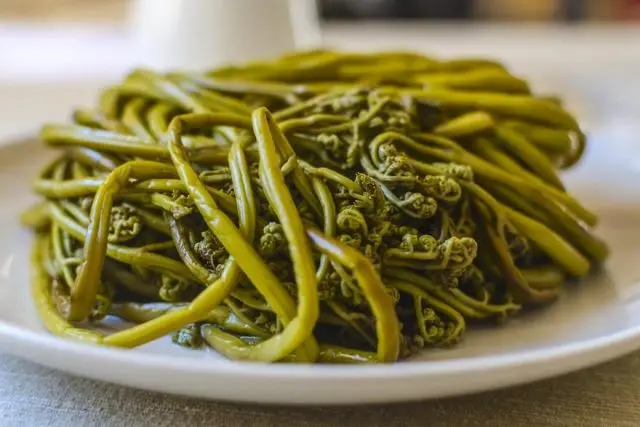
Benefits of Salted Fern
Fern is considered a low-calorie product, which includes many vitamins, minerals and nutrients. Young shoots of this plant contain B, A, E, PP vitamins, saponins and flavonoids. The calorie content of salted fern is about 39 kcal per 100 g serving.
Thanks to such a rich chemical composition, salted fern brings invaluable benefits to the body:
- has a strengthening effect on the immune system;
- normalizes the work of the heart and blood vessels;
- improves the functioning of the thyroid gland;
- normalizes the work of the digestive tract;
- has a positive effect on metabolism;
- normalizes blood sugar levels;
- strengthens bones.
The benefits and harms of salted fern are incomparable. There are only a few contraindications to its use:
- pregnancy;
- serious diseases of the internal organs.
How to salt a fern for the winter
There are many recipes for preparing salted fern for the winter. The first step is always the preparation of raw materials. The shoots of this plant can be purchased at the supermarket, ordered from specialized online stores, or prepared independently.
The collection of raw materials is usually carried out when lilies of the valley bloom. As can be seen from the photo of the salted fern, the cuttings, called rachis, are in a folded state during this period. When they open, the plant becomes unfit for human consumption. Salting is carried out in the near future after collecting the shoots (no more than 4 hours), otherwise, they will become too rough.
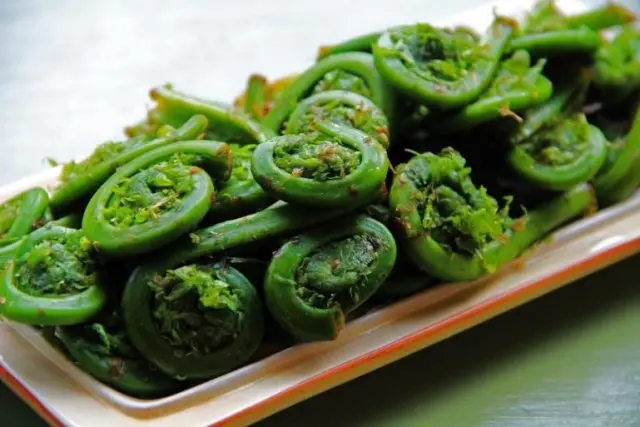
Fern salting according to the classic recipe in a large container
According to the classic recipe, fern is usually salted in large containers, which can be used as bulk pots, basins, buckets and even a bath. The main thing is to store salting in a cool room. For 10 kg of raw materials, according to the recipe, 3-4 kg of salt will be required.
Salting algorithm:
- sort out the cuttings, rinse with water 2-3 times, dry slightly with a towel;
- lay the shoots and salt in layers in a container, evenly distributing the products;
- establish oppression, which can be used as a variety of objects: the main thing is that its mass is equal to the mass of salty raw materials;
- keep the container with oppression in a cool temperature should be within 2 – 3 weeks;
- after that, it is necessary to drain the resulting liquid, spread the shoots into separate sterilized containers and, tightly tamping, cover with a lid.
You need to store pickles in a cool place for about 2 weeks: the dish will be completely ready for use.
How to salt a fern at home in a dry way
Dry salting:
- Rinse the fresh shoots well, this will remove the scales from the leaves.
- With the help of rubber bands, collect the shoots in bunches.
- Place the cuttings in a container in layers, sprinkling each of them with coarse salt. For 10 kg of raw materials, about 4 kg of salt will be required.
- Place weight on top.
- Salt in the cellar under oppression for 21 days.
- The brine formed during salting must be drained.
- Salt the plant mass additionally at the rate of 2 kg of salt per 10 kg of raw materials.
The resulting dish is subsequently best packaged in separate jars.
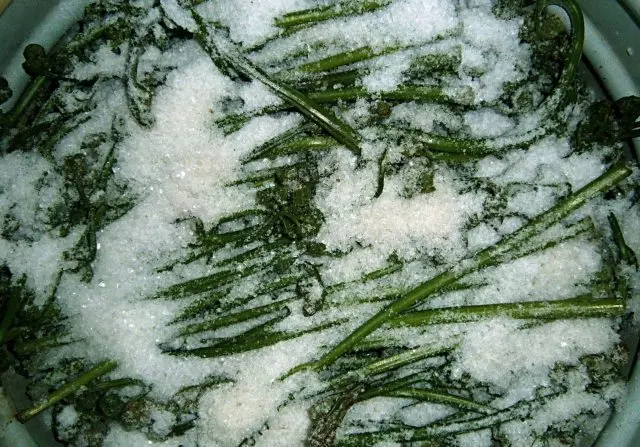
Fern salting according to GOST
The method of salting according to GOST is based on triple salting and a combination of the dry method with the brine.
First salting:
- rinse the fern, collect the stems in bunches about 20 cm thick;
- put in layers on the bottom of a wooden barrel or plastic bucket, sprinkling with salt at the rate of 4 kg of salt per 10 kg of raw materials;
- cover with a flat lid, set oppression on top;
- leave for 21 days: during this time, all toxins will come out of the cuttings and bitterness will disappear.
Second salting:
- drain the resulting juice, transfer the cuttings to another container;
- pour salt in layers (1,5 kg of salt per 10 kg of raw materials);
- prepare a brine by mixing 10 liters of water with 1 kg of salt;
- pour the cuttings with brine so that they are completely immersed in the solution;
- set oppression with a weight equal to 50% of the original weight of the product;
- leave for 10 – 15 days.
Third salting:
- prepare a saline solution by mixing 2,5 kg of salt with 10 liters of water;
- drain the old liquid from the container;
- sort out the bunches, getting rid of the reddish and yellowish-brown cuttings;
- pour the bundles with new brine in an old container or immediately pack them in a separate glass container and roll up the lids.
After 20 days, the salt will be ready.
Shoots salted using this technology can remain fresh for two years.
How to pickle a fern in the taiga
As a result of salting in the taiga style, the dish will turn out to be very salty, however, it will be stored much longer. In the recipe below, 1 kg of salt is taken for 0,5 kg of plant shoots.
Salting algorithm in the taiga:
- cut off the coarsened parts of the shoots, the remaining ones – rinse and put on the bottom of the container;
- mix with salt in a convenient way: laying out in layers or tamping tightly;
- leave for 3 days;
- mix thoroughly, add a little more salt;
- press down with a load, leave for a few more days;
- put in glass jars and roll up the lids to increase the shelf life.
If the fern is too salty, you can soak it in cold water overnight. After this procedure, the shoots will taste like fresh ones.
How to salt a fern in a brine way
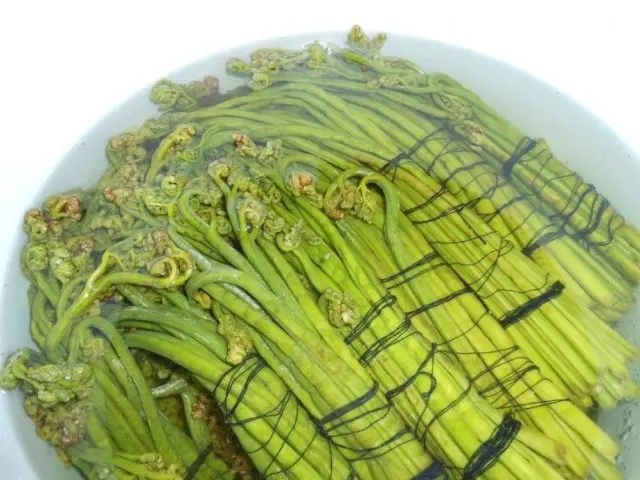
Salting a plant in a brine way is quite simple, for this you need:
- put the stems collected in bundles on the bottom of the container (you can use a wide basin);
- completely fill with boiling water and cover with a lid, let it brew;
- cool and then drain the liquid;
- repeat the procedure 2 times;
- put processed raw materials in sterilized jars;
- prepare a hot brine (15 g of salt per 1 liter of water) and fill it with raw materials;
- roll up the banks.
How to Salt Ferns with Regular Fluid Changes
Quite interesting is the salting method, in which the liquid is regularly changed. It will take 2 weeks to prepare a delicacy according to this recipe, and salted cuttings are unusually tender and soft.
Salting technology:
- wash the stems and cut them into pieces;
- sprinkle with salt in layers, pour water;
- place a plank on the surface, set oppression;
- let it brew for 3 days;
- drain the resulting liquid into another container;
- drain 2/3 of the liquid and mix with 1/3 of cool water;
- insist another 4 days;
- drain the released juice, mix with 600 g of salt;
- pour cuttings and insist 3 days;
- pour out 1/3 of the liquid, replacing it with clean water;
- salt for another 4 days;
- drain all the juice, and put the fern in airtight containers.
How to pickle a fern immediately in jars
Fern can be salted immediately in glass jars. For this you need:
- rinse the stems with water;
- boil them in a light saline solution for 10 – 15 minutes;
- put in sterilized jars;
- pour hot brine (15 g of salt per 1 liter of water);
- roll up the jars, turn upside down and leave under a warm cover until completely cooled.
Such a blank can be safely stored in the cellar or refrigerator all winter.
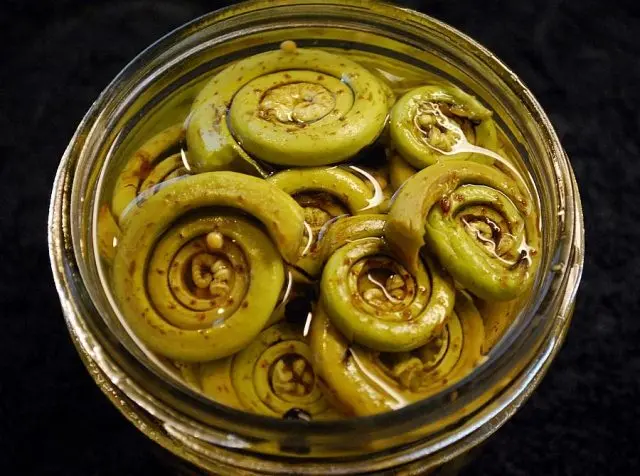
An accelerated way of pickling a fern
If you use the accelerated salting method, the shoots will be ready for use after a day.
Technology of preparation:
- washed shoots must first be boiled for 10 – 15 minutes;
- after drain all the water and mix the raw materials with salt (300 g per 1 kg of shoots);
- leave to infuse for a day.
How to salt a fern in a barrel
In a barrel, you can immediately pickle a large amount of fern, 10 kg of salt will be required for 4 kg of raw materials. For salting in this way you need:
- line the bottom of the barrel with polyethylene;
- pour a layer of salt, then lay out a layer of ferns and another layer of salt;
- put oppression on top and insist 3 weeks;
- prepare a second barrel and transfer the shoots into it, adding another 1 kg of salt;
- set oppression again for 3 weeks;
- prepare a brine by dissolving 1 kg of salt in 10 kg of water;
- replace the resulting juice in the barrel with brine;
- insist 3 weeks, then decompose into banks.
To get rid of excess salt, salted fern can be boiled before eating.
How to store salted fern
According to the technological instructions, the shelf life of salted fern is 1 year. At the same time, it must be stored at an air temperature of 0 to 20 degrees. The humidity level in the room should be no more than 95%.
When stored in a cellar or refrigerator and the correct preparation of the product, the shelf life can increase up to 2 years. If the blanks are stored in glass containers, then the terms increase even more. At the same time, as various experiments and experiments show, the taste qualities and useful properties of pickles do not change in any way.
What can be made from salted fern

Salted fern can be eaten as a meal on its own. Such an exotic appetizer is sure to surprise guests at the festive table. For greater effect, you can serve the dish with other canned vegetables: cherry tomatoes, gherkins or corn, and sprinkle sesame seeds on top.
With salted fern, you can make many unusual dishes rich in vitamins. In salads, this delicacy goes well with shrimp, squid, pork, eggs, cucumbers, potatoes, carrots, fresh herbs, onions and garlic.
Rice and potato soups with the addition of fern are widespread. The broth for such soups is most often boiled on pork bones. Fern fried with beef meat is considered the signature dish of the inhabitants of the Far East. The meat does not need to be salted during frying. The dish can be served both cold and hot.
Conclusion
Salting fern at home is a simple process, the main thing is to choose the best method and strictly adhere to the cooking technology. The result may not be to everyone’s taste, but it will definitely please fans of unusual dishes.









